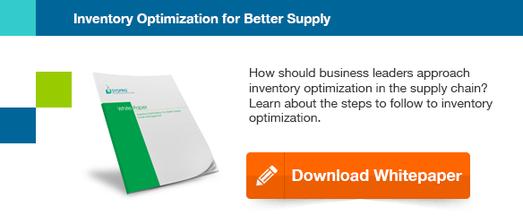So you reckon I should consider inventory optimization? Convince me.
According to research by the Aberdeen Group, one of the top pressures is unpredictable demand , another pressure is reducing inventory carrying costs . How are business leaders addressing these pressures? By building capacity for better demand and inventory planning and forecasting.
But aren’t those actions only for large companies? Not really, because many companies, both large and small, have a similar problem. It’s the cash flow gap between the time inventory is paid for and when cash is received for goods sold. The APICS Supply Chain Council has a metric for it – cash-to-cash cycle time.
So if inventory costs money and negatively impacts my cash flow, why not just reduce it? You could, but this is a reactive response to the problem. How much inventory you hold depends on demand factors, supply lead times, manufacturing capacity, and your stock holding policies. Cutting it just papers over the cracks in the organization. A better way is to optimize your inventory.
In many companies, inventory levels are still determined by rule-of-thumb or safety-first strategies. Rule-of-thumb could be days of supply; safety-first is having something “just in case”. Fear of the unknown can also lead to additional stock being added. Ten years ago, inventory optimization (IO) was a complex undertaking – the process of objectively determining the right inventory levels for different products classes or SKUs, when to re-order and how much, was not simple. But thanks to advances in technology this has changed.
If you have an ERP like SYSPRO, you have the software and the data to give you a data-driven solution, rather than relying on rule-of-thumb or guess work. IO software allows you to estimate your inventory levels to maximize profit and minimize waste. It can model different potential outcomes using a number of variables, and help you pick the best stock holding and re-order policy for each product group or set of SKUs.
Why should I go to the trouble of implementing IO, isn’t it really a “nice to have” rather than a “need to have”? A study by the American Productivity and Quality Center noted that the average cost of carrying inventory is 10 percent of the annual value of inventory. The Aberdeen research mentioned earlier shows how using IO software can save money, for example:
With IO Without IO
Carrying cost reduction % decrease 36% 27%
Gross margin % 26% 22%
Using IO as part of your overall stock holding policy will give you a better view of demand, which will enable you to reduce both safety stock levels and overall inventory. This is what you wanted in the first place, but now it’s based on actual data and a better application of your stock holding policies. Also, you can now start investigating how to make your supply chain leaner as IO often shows where waste exists in the supply chain.
OK, so how do I start optimizing inventory? Like dieting, IO is not a one-off activity, it’s a business lifestyle you have to adopt. A good IO solution provides well-designed and effective processes, and regular assessment. It’s something that requires continuous review, ongoing education, and occasional re-alignment. But unlike a good diet, IO presents the opportunity for big gains.
* Thanks to Dave Waller of K3 SYSPRO for the inspiration to write this







